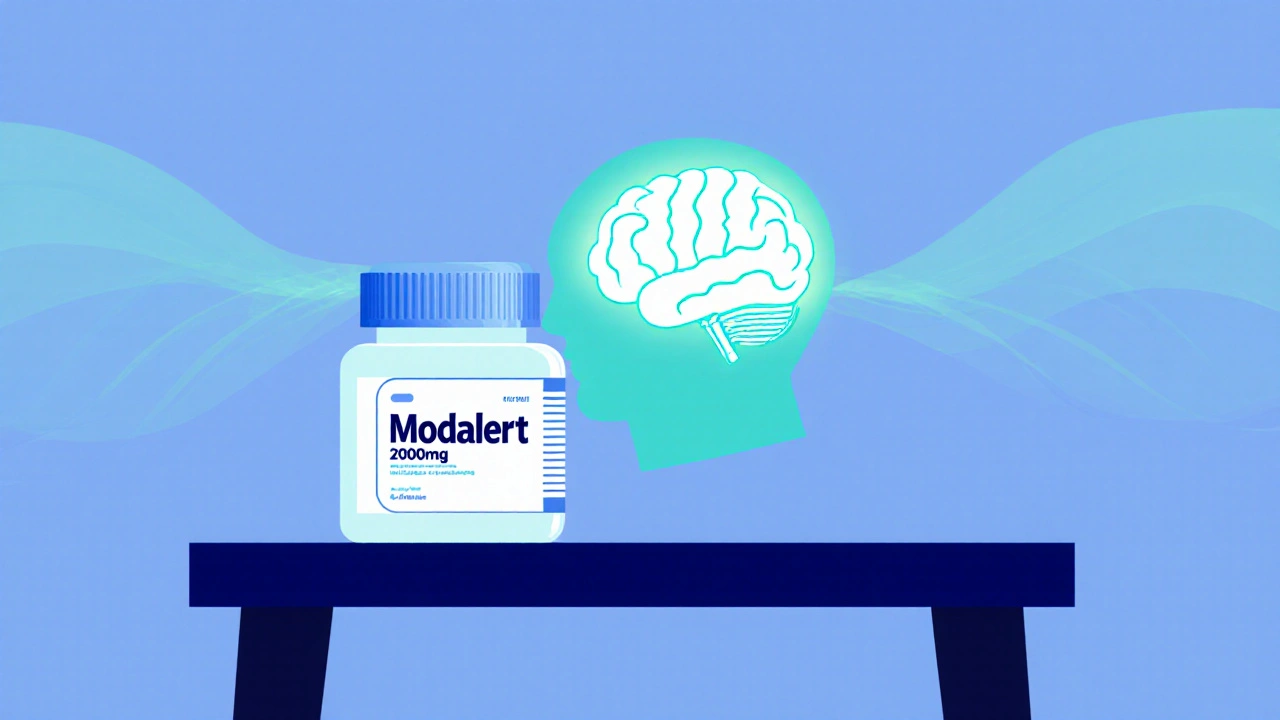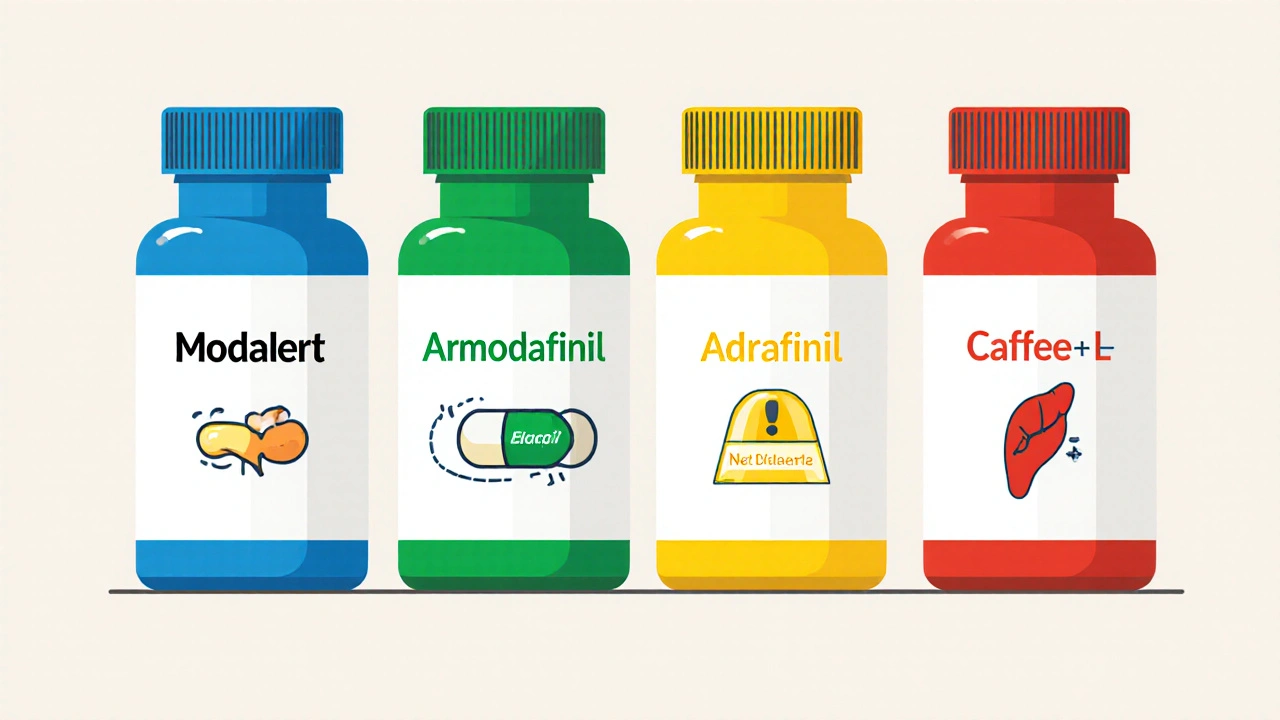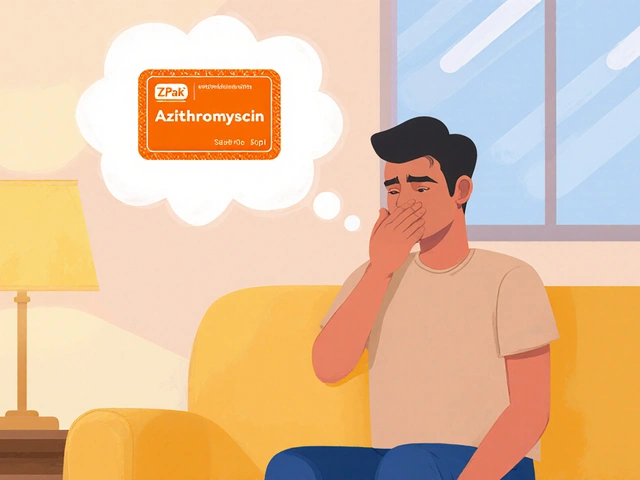
Modalert is one of the most talked-about nootropics for staying awake and sharp. But if you’ve looked into it, you’ve probably seen a dozen other names pop up: armodafinil, adrafinil, piracetam, even caffeine stacks. The question isn’t just whether Modalert works-it’s whether something else works better for Modafinil users like you.
What Exactly Is Modalert?
Modalert is a brand name for modafinil, a prescription drug originally developed in France in the 1970s to treat narcolepsy. It’s not a stimulant like amphetamines. Instead, it targets specific brain chemicals-dopamine, orexin, and histamine-to promote wakefulness without the jittery crash. People use it off-label for focus, productivity, and long work hours. In the UK, it’s not licensed for general use, so most get it through online pharmacies, often from India or other countries where it’s sold over-the-counter.
Modalert comes in 200mg tablets. Most users take one in the morning. Effects kick in within 30-60 minutes and last 12-16 hours. It doesn’t feel like caffeine. There’s no heart palpitations or anxiety spike. Instead, users report a calm, clear-headed alertness-like your brain finally stopped running on low battery.
Armodafinil: The Longer-Lasting Cousin
Armodafinil is the R-enantiomer of modafinil. That’s a fancy way of saying it’s a purified version of one of the two molecules that make up modafinil. The result? A longer half-life. While modafinil lasts about 12-15 hours, armodafinil can stretch to 15-17 hours.
Brands like Nuvigil and Artvigil contain armodafinil. Many users switch because they don’t want the mid-afternoon dip. If you’re working a 10-hour shift or studying for an all-nighter, armodafinil gives you more consistent coverage. But it’s also more expensive. A 150mg tablet of Artvigil costs nearly twice as much as a 200mg Modalert pill.
Side effects are nearly identical: headache, nausea, insomnia. But because armodafinil is more potent by weight, some find it harder to tolerate at higher doses. If you’ve had trouble with modafinil’s intensity, armodafinil might not be the fix.
Adrafinil: The Prodrug That Turns Into Modafinil
Adrafinil is what modafinil used to be before it got regulated. It’s not modafinil itself-it’s a precursor your liver converts into modafinil. That means you need about 300mg of adrafinil to get the same effect as 200mg of modafinil.
It’s legal in the UK because it’s not classified as a controlled substance. That’s why it’s still sold as a supplement. But here’s the catch: your liver has to do the work. Long-term use can stress liver enzymes. Studies show elevated ALT and AST levels in users taking 600mg+ daily over months. If you’re already on other meds or have liver concerns, this isn’t safe.
Adrafinil also takes longer to kick in-60-90 minutes. You can’t use it for last-minute focus. But if you want something legal, cheap, and easy to find, it’s still popular. Just don’t take it daily. Cycle it: 3 days on, 4 days off.
Piracetam: The Original Nootropic
Piracetam was developed in the 1960s. It’s the grandfather of all nootropics. Unlike modafinil, it doesn’t directly affect dopamine or wakefulness pathways. Instead, it enhances communication between brain cells by improving membrane fluidity and acetylcholine function.
It’s mild. You won’t feel a surge of energy. But over time, users report better memory recall, faster learning, and reduced mental fatigue. It’s often stacked with choline sources like Alpha-GPC to prevent headaches.
Studies show piracetam helps with cognitive decline in older adults and improves focus in students. But it’s not a wakefulness drug. If you’re pulling an all-nighter, piracetam won’t keep you awake. It’s better for long-term brain support than short-term alertness.
Dosage: 1,200-4,800mg daily, split into two or three doses. Side effects are rare but include mild anxiety or insomnia if taken late.

Caffeine + L-Theanine: The Natural Stack
You don’t need a prescription or a foreign pharmacy to get results. Caffeine and L-theanine, taken together, mimic modafinil’s calm focus without the risk.
Caffeine blocks adenosine receptors, making you alert. L-theanine, an amino acid in green tea, increases alpha brain waves-calm, focused states. Together, they cancel out the jitters and give you smooth, sustained concentration.
Studies from the University of Birmingham and others show this combo improves attention, reaction time, and mood better than caffeine alone. A 100mg caffeine + 200mg L-theanine dose is the sweet spot. You can get it in capsules or just drink green tea with a cup of coffee.
Pros: cheap, legal, no liver strain, no dependency risk. Cons: effects last only 4-6 hours. You’ll need to re-dose if you’re working long hours.
Other Alternatives: Phenylpiracetam, Oxiracetam, and More
Phenylpiracetam is a stronger version of piracetam with a phenyl group attached. It crosses the blood-brain barrier faster and has mild stimulant properties. Users report increased physical energy alongside mental clarity. Dose: 100-200mg. It’s not for daily use-tolerance builds fast.
Oxiracetam is another racetam that enhances logical thinking and memory. It’s good for problem-solving tasks but doesn’t help with wakefulness. Dose: 750-1,500mg twice daily.
Then there’s methylphenidate (Ritalin) and amphetamines (Adderall). These are stimulants with high abuse potential. They’re not alternatives-they’re different beasts entirely. They come with risks: addiction, heart strain, crashes, and legal trouble in the UK.
Which One Should You Choose?
Let’s cut through the noise. Here’s what works best, based on real-world use and safety:
- For all-day focus without crashes: Modalert or armodafinil. Choose armodafinil if you need longer coverage and can afford it.
- For legal, low-cost, occasional use: Adrafinil-but cycle it and monitor liver health.
- For long-term brain support, not wakefulness: Piracetam + choline.
- For natural, safe, daily use: Caffeine + L-theanine.
- Avoid: Ritalin, Adderall, and high-dose stimulants unless prescribed.
Most people who switch from modafinil to alternatives do it for one of three reasons: cost, legality, or side effects. If you’re using Modalert for productivity, don’t assume it’s the only option. The best choice depends on your goals, tolerance, and health.
Common Mistakes People Make
Many users think more is better. Taking 400mg of Modalert won’t make you twice as focused-it’ll just give you a headache and insomnia. Stick to 100-200mg.
Another mistake: combining modafinil with other stimulants. Coffee, energy drinks, or pre-workout supplements can push your heart rate into dangerous territory. Don’t stack them.
And never assume these drugs are harmless because they’re “not drugs.” Modafinil affects your brain chemistry. Long-term use without breaks can reduce natural dopamine sensitivity. Cycle it: 5 days on, 2 days off. Or use it only when you really need it.
Final Thoughts: No Magic Pill
Modalert and its alternatives can help with focus and wakefulness. But they’re not replacements for sleep, nutrition, or stress management. If you’re constantly relying on them, ask why. Are you overworked? Under-slept? Stressed out?
These substances can be tools. But tools don’t fix broken systems. Use them wisely. Stack them smartly. And never forget: the best cognitive enhancer is still a good night’s sleep.
Is Modalert legal in the UK?
Modalert (modafinil) is a prescription-only medication in the UK. It’s not approved for off-label use like productivity enhancement. Buying it online without a prescription is legally gray-while possession isn’t illegal, importing it for personal use may violate customs rules. Many users still get it from overseas suppliers, but there’s no guarantee of quality or legality.
Can you build tolerance to Modalert?
Yes. Regular daily use can reduce its effectiveness over time. Your brain adapts to the increased dopamine and orexin activity. Most users report diminished effects after 3-6 weeks of daily use. Cycling-taking it 3-5 days a week instead of every day-helps maintain sensitivity. Some take breaks for a week every month.
Does Modalert show up on drug tests?
Standard workplace drug tests don’t screen for modafinil. But specialized tests (used in sports or military settings) can detect it. Modafinil stays in your system for about 15-20 hours, so if you take it in the morning, it’s usually cleared by the next day. Still, if you’re subject to drug screening, it’s safer to avoid it altogether.
Which alternative is safest for daily use?
Caffeine + L-theanine is the safest option for daily use. It’s natural, non-addictive, and doesn’t stress your liver or brain chemistry. Piracetam is also safe for long-term use but doesn’t provide wakefulness. Avoid adrafinil and modafinil for daily use-risk of tolerance and liver strain increases with frequency.
Can you combine Modalert with other nootropics?
Some users combine Modalert with choline sources (like Alpha-GPC) to prevent headaches and improve memory. Others add low-dose L-theanine to smooth out any sharpness. But avoid combining it with stimulants like caffeine, synephrine, or yohimbine. That raises blood pressure and heart rate risk. Always start low and go slow.
What to Do Next
If you’re considering alternatives to Modalert, start with caffeine + L-theanine. It’s accessible, affordable, and safe. If you need stronger effects, try armodafinil-but only occasionally and never daily. Keep a journal: track your energy, sleep, and mood. You’ll quickly see what works for your body.
And if you’re using these substances to cope with chronic fatigue, burnout, or poor sleep habits, consider talking to a doctor. No pill fixes a broken lifestyle. But used correctly, they can help you get back on track.




Pradeep Kumar
November 1, 2025 AT 16:47Been using caffeine + L-theanine for 2 years now and never looked back. No crashes, no jitters, just steady focus. I used to take Modalert every other day but ended up with brain fog and insomnia. This combo is cheaper, legal, and I can take it daily without guilt. Green tea + black coffee = my new morning ritual. 🌿☕
Manuel Gonzalez
November 3, 2025 AT 09:40Great breakdown. I appreciate how you didn't just list options but explained why each one fits different needs. The liver warning on adrafinil is crucial - too many people treat it like a supplement when it's basically a metabolic burden. Also, the sleep point at the end? Spot on. No pill fixes burnout.
Justin Vaughan
November 4, 2025 AT 13:04Modalert is great for one-off focus bombs - like prepping for a big presentation or pulling a rare all-nighter. But if you're using it weekly, you're training your brain to need chemical help to function. I switched to piracetam + choline for long-term brain health. It’s like upgrading your RAM instead of just cranking up the fan speed. Slow, subtle, sustainable. And no weird side effects.
Melissa Kummer
November 5, 2025 AT 13:44As someone who works 12-hour days in healthcare, I’ve tried nearly all of these. Armodafinil gave me the longest window of clarity, but at $12 per pill, it’s not sustainable. Modalert at $3 is my go-to, but I cycle strictly: 5 days on, 2 off. And yes - never mix with caffeine. My heart was racing like a racecar. Learned that the hard way.
Jens Petersen
November 6, 2025 AT 10:58Let’s be real - if you’re relying on nootropics to get through your day, you’re not a biohacker, you’re a broken system. Modafinil is just corporate fuel for overworked millennials who refuse to quit their soul-crushing jobs. The real solution? Get a better job. Sleep. Eat real food. Stop treating your brain like a smartphone that needs a power bank. You’re not special because you take pills to be productive. You’re just exhausted.
Matthew Kwiecinski
November 6, 2025 AT 17:24Adrafinil is not legal in the UK. It’s unregulated, yes, but under the Medicines Act, it’s still considered a medicinal product without authorization. Importing it is technically illegal under the Human Medicines Regulations 2012. Don’t let online vendors fool you with ‘supplement’ labels. It’s a grey area, but the law doesn’t care about your productivity goals.
Leslie Schnack
November 8, 2025 AT 15:17Has anyone tried combining piracetam with low-dose modafinil? I did it once - 400mg piracetam + 100mg modalert - and got this weird calm hyperfocus where I could read dense academic papers for hours without blinking. No anxiety, no crash. Just pure mental flow. I stopped after a week because I didn’t want to risk tolerance. But it worked.
Emmalee Amthor
November 10, 2025 AT 04:13Modalert is overrated 😩 I tried it once and felt like my brain was wrapped in plastic. Like I was awake but not really there. Caffeine + L-theanine gave me better focus without the dissociation. Also, I sleep better. Sleep is the original nootropic. Stop pretending otherwise.
Andy Ruff
November 11, 2025 AT 14:35People who use piracetam are just deluding themselves. It’s a placebo with a fancy name. You don’t ‘enhance memory’ with a racetam - you just convince yourself you’re smarter because you took a powder. Meanwhile, real people use armodafinil to get actual work done. Stop pretending mild cognitive nudges are ‘brain optimization.’ It’s not biohacking - it’s self-help gobbledygook.
Justin Vaughan
November 12, 2025 AT 18:06And yet, peer-reviewed studies show piracetam improves verbal memory in elderly patients and reduces cognitive fatigue in students. It’s not a magic bullet, but calling it a placebo ignores decades of clinical research. You want ‘real work done’? Fine. But don’t dismiss science because it doesn’t match your adrenaline-fueled hustle fantasy.
Saumyata Tiwari
November 12, 2025 AT 20:51Modalert is made in India. Why are you all pretending it’s some Western miracle drug? Our labs produce better quality than the so-called ‘premium’ brands. Artvigil? Overpriced. Modalert? Effective. Stop the colonial mindset. Just because it’s cheaper doesn’t mean it’s inferior. We’ve been doing this right for decades.
Brittney Lopez
November 13, 2025 AT 00:55Thank you for this. I’ve been using caffeine + L-theanine daily and it’s changed my life. I used to feel like I needed modafinil to be ‘productive,’ but now I just feel… present. Also, I started journaling my sleep and noticed I was burning out from trying to be ‘always on.’ This isn’t about drugs. It’s about listening to your body.